Items
Tag
Building the Brafferton
-
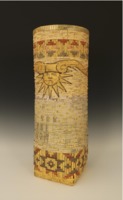 Laying the Foundation This Cherokee single weave–style basket is comprised of documents and images pertaining to the Brafferton’s history, including the College’s 1693 Charter, Robert Boyle’s will, ledger sheets, the Bursar’s book records and a blueprint used in the building’s reconstruction. The base pattern offers an indigenous balance to the colonial sun emblem, a symbol for enlightenment. The interior features part of a speech from the Brafferton’s 2011 rededication ceremony.
Laying the Foundation This Cherokee single weave–style basket is comprised of documents and images pertaining to the Brafferton’s history, including the College’s 1693 Charter, Robert Boyle’s will, ledger sheets, the Bursar’s book records and a blueprint used in the building’s reconstruction. The base pattern offers an indigenous balance to the colonial sun emblem, a symbol for enlightenment. The interior features part of a speech from the Brafferton’s 2011 rededication ceremony. -
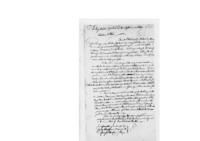 George Washington Papers, Series 4, General Correspondence: George Washington, August 1, 1756, Speech to Tuscarora Indians
George Washington Papers, Series 4, General Correspondence: George Washington, August 1, 1756, Speech to Tuscarora Indians
-
 George Washington Papers, Series 4, General Correspondence: Henry Bawbee to George Washington, December 7, 1780, with Sketch of Fort at Detroit
George Washington Papers, Series 4, General Correspondence: Henry Bawbee to George Washington, December 7, 1780, with Sketch of Fort at Detroit
-
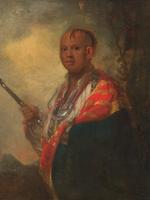 Portrait of Syacust Ukah, 1762
Portrait of Syacust Ukah, 1762
-
 Cunne Shote, Cherokee Chief
Cunne Shote, Cherokee Chief
-
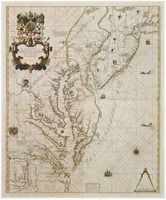 A New Map of/ VIRGINIA./ MARYLAND, PENSILVANIA,/ NEW JERSEY, Part of NEW YORK,/ And CAROLINA The upper left cartouche reads: "A New Map of/ VIRGINIA./ MARYLAND, PENSILVANIA,/ NEW JERSEY, Part of NEW YORK,/ And CAROLINA./ Sold by T. Page W. & F. Mount on Tower Hill" The lower left cartouche beneath the coat of arms reads: "To M.r Micajah Perry of London Merchant/ This Map of VIRGINIA &c./ is humbly Dedicated and Presented/ Thornton,"
A New Map of/ VIRGINIA./ MARYLAND, PENSILVANIA,/ NEW JERSEY, Part of NEW YORK,/ And CAROLINA The upper left cartouche reads: "A New Map of/ VIRGINIA./ MARYLAND, PENSILVANIA,/ NEW JERSEY, Part of NEW YORK,/ And CAROLINA./ Sold by T. Page W. & F. Mount on Tower Hill" The lower left cartouche beneath the coat of arms reads: "To M.r Micajah Perry of London Merchant/ This Map of VIRGINIA &c./ is humbly Dedicated and Presented/ Thornton," -
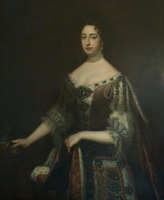 Portrait of Queen Mary II of England (1662 - 1694) Mary was born on April 30, 1662, during the reign of her uncle, Charles II. Her father, James, was first in line to the throne but he was Catholic, which made him unpopular in England. As a result, Charles required Mary to be raised as a Protestant. Three years later, James succeeded Charles, but he was deposed in the Glorious Revolution of 1688, where Mary and her husband as well as first cousin, William of Orange, succeeded him in 1689. Mary was devoted to her husband and reluctant to assume power in his absence, but she proved to be a strong and capable monarch when the need arose. The couple had no children; there is speculation that an early miscarriage permanently impaired Mary’s ability to have children. She was extremely devout and dedicated much of her time to ecclesiastical affairs. In addition, Mary endowed the College of William & Mary in 1692, helped found the Society for Promoting Christian Knowledge, and the Royal Hospital for Seamen. Mary was tall and apparently fit, but in 1694 she contracted smallpox. She died on December 28, 1694. William was devastated and reigned on as sole monarch until his death in 1702.
Portrait of Queen Mary II of England (1662 - 1694) Mary was born on April 30, 1662, during the reign of her uncle, Charles II. Her father, James, was first in line to the throne but he was Catholic, which made him unpopular in England. As a result, Charles required Mary to be raised as a Protestant. Three years later, James succeeded Charles, but he was deposed in the Glorious Revolution of 1688, where Mary and her husband as well as first cousin, William of Orange, succeeded him in 1689. Mary was devoted to her husband and reluctant to assume power in his absence, but she proved to be a strong and capable monarch when the need arose. The couple had no children; there is speculation that an early miscarriage permanently impaired Mary’s ability to have children. She was extremely devout and dedicated much of her time to ecclesiastical affairs. In addition, Mary endowed the College of William & Mary in 1692, helped found the Society for Promoting Christian Knowledge, and the Royal Hospital for Seamen. Mary was tall and apparently fit, but in 1694 she contracted smallpox. She died on December 28, 1694. William was devastated and reigned on as sole monarch until his death in 1702. -
 Portrait of King William III of England (1650 - 1702)
Portrait of King William III of England (1650 - 1702)
-
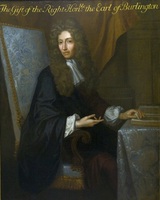 Portrait of Robert Boyle Donated by the sitter’s nephew, the Third Earl of Burlington, in 1732, this portrait of celebrated scientist Robert Boyle was the first work of art acquired by The College of William and Mary. Boyle was renowned for the discovery, later known as “Boyle’s Law,” of the mathematical relationship between the pressure and volume of a gas. Upon his death, funds from his estate at Brafferton Manor in Yorkshire, England, founded the first Indian school in the New World, located at the College and named “Brafferton” after Boyle’s manor house. James Worsdale, a student of Sir Godfrey Kneller, based this work on a 1689 portrait of Boyle by Johann Kerseboom, a German-born artist active in England in the late 17th century and the first decade of the 18th century.
Portrait of Robert Boyle Donated by the sitter’s nephew, the Third Earl of Burlington, in 1732, this portrait of celebrated scientist Robert Boyle was the first work of art acquired by The College of William and Mary. Boyle was renowned for the discovery, later known as “Boyle’s Law,” of the mathematical relationship between the pressure and volume of a gas. Upon his death, funds from his estate at Brafferton Manor in Yorkshire, England, founded the first Indian school in the New World, located at the College and named “Brafferton” after Boyle’s manor house. James Worsdale, a student of Sir Godfrey Kneller, based this work on a 1689 portrait of Boyle by Johann Kerseboom, a German-born artist active in England in the late 17th century and the first decade of the 18th century. -
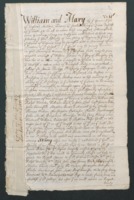 College of William and Mary Royal Charter This 1693 contemporary copy of Charter was probably made for the personal reference of Sir Edmund Andros. Purchased by the College in 1970s
College of William and Mary Royal Charter This 1693 contemporary copy of Charter was probably made for the personal reference of Sir Edmund Andros. Purchased by the College in 1970s -
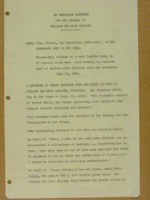 Copy of Sir Robert Boyle's Will
Copy of Sir Robert Boyle's Will